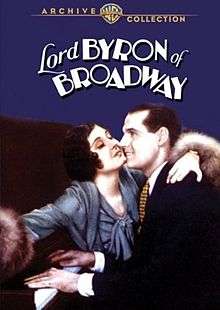Lord Byron of Broadway
| Lord Byron of Broadway | |
|---|---|
 | |
| Directed by |
Harry Beaumont William Nigh |
| Written by |
Nell Martin (novel) Crane Wilbur |
| Starring |
Charles Kaley Ethelind Terry Marion Shilling Clifton Edwards |
| Music by |
Songs:: Nacio Herb Brown (music) Arthur Freed (lyrics) |
| Cinematography | Henry Sharp |
| Edited by | Anne Bauchens |
| Distributed by | Metro-Goldwyn-Mayer |
Release dates | February 28, 1930 |
Running time | 66 or 77 minutes (sources differ) |
| Country | United States |
| Language | English |
Lord Byron of Broadway (1930), also known as What Price Melody?, is an American Pre-Code musical drama film, directed by Harry Beaumont and William Nigh. It was based on a best selling book by Nell Martin, which "was widely praised by critics as an extremely true and amusing romance of stage life."[1] It was filmed in black and white with two-color Technicolor sequences.
Cast
- Charles Kaley as Roy Erskine
- Ethelind Terry as Ardis Trevelyn
- Marion Shilling as Nancy Clover
- Cliff Edwards as Joe Lundeen
- Gwen Lee as Bessie ("Bess")
- Benny Rubin as Phil
- Jack Byron as Mr. Millaire (as John Byron)
- Gino Corrado as Riccardi
- Iris Adrian (uncredited)
- Jack Benny (uncredited)
- Ann Dvorak (uncredited)
Soundtrack
Charles Kaley recorded two of the songs for Brunswick Records (Record Number 4718). These songs were "Should I" and "A Bundle of Love Letters". Both of these songs proved to be major song hits in late 1929 and early 1930 and were recorded by numerous artists. For example, James Melton and Lewis James recorded vocal versions of "A Bundle of Love Letters" while Frank Munn recorded "Should I".
- "A Bundle of Love Letters"
- (1930)
- Music by Nacio Herb Brown
- Lyrics Arthur Freed
- Played on piano by Marion Shilling and sung by Charles Kaley
- Played on piano by Marion Shilling and sung by Cliff Edwards and Charles Kaley in a vaudeville show
- (1920)
- Music Richard A. Whiting
- Lyrics by Ray Egan
- Sung by Cliff Edwards in his vaudeville show
- "The Doll Dance"
- Music by Nacio Herb Brown
- Lyrics Arthur Freed
- Danced to by Rita Flynn and Hazel Craven in a vaudeville show
- "Blue Daughter of Heaven"
- (1930)
- Music by Dimitri Tiomkin
- Lyrics by Ray Egan
- Sung offscreen by James Burroughs and danced to by Albertina Rasch Ballet\
- "Should I?"
- (1930)
- Music by Nacio Herb Brown
- Lyrics Arthur Freed
- Sung by Charles Kaley at a nightclub
- Reprised by Ethelind Terry at a recording studio
- Played at the end
- "The Woman in the Shoe"
- (1930)
- Music by Nacio Herb Brown
- Lyrics Arthur Freed
- Sung by Ethelind Terry, an offscreen male singer and the chorus in a show
- Danced to by the chorus
- Reprised by male trio
- "Old Pal, Why Did You Leave Me?"
- (1930)
- Music by Nacio Herb Brown
- Lyrics Arthur Freed
- Played on piano and sung by Charles Kaley and Benny Rubin
- "Only Love Is Real"
- (1930)
- Music by Nacio Herb Brown
- Lyrics Arthur Freed
- Played on piano by Marion Shilling on radio and sung by an unidentified male singer
- Reprised by Ethelind Terry on radio
- "You're the Bride and I'm the Groom"
- (1930)
- Music by Nacio Herb Brown
- Lyrics Arthur Freed
- Played on piano and sung by Charles Kaley
- "Love Ain't Nothin' But the Blues"
- (1930)
- (From "Chasing Rainbows (1930)")
- Music by Louis Alter
- Lyrics by Joe Goodwin
- Played instrumentally
Production
In 1928, MGM announced it was going to turn the novel Lord Byron of Broadway by Nell Martin into a musical starring stars William Haines and Bessie Love. However, as they both had mediocre singing voices, they were replaced by Charles Kaley, star of Earl Carroll's Vanities and Ethelind Terry, star of Florenz Ziegfeld's Rio Rita. At that time, Kaley and Terry were well-known stage stars.[2]
MGM used the "Woman in the Shoe" musical segment in two short films, Nertsery Rhymes (1933) and Roast Beef and Movies (1934).
Critical response
The expensive film received mixed reviews, mainly due to the lackluster direction of William Nigh and Harry Beaumont. Its Technicolor sequences and musical score, however, were universally praised.[3] "The story's strong enough to be festooned with Technicolored girls, ballets, songs and effects without breaking down," said Photoplay "You'll like this."[4]
Sheet music sales and sales of phonograph records with songs from the film were brisk. "Should I" and "A Bundle of Old Love Letters" proved to be among the most popular song hits of the year 1930.
See also
References
- Notes
- ↑ The Southeast Missourian, July 19, 1930
- ↑ The Sunday Morning Star (April 6, 1930)
- ↑ The Sydney Morning Herald - May 12, 1930 https://news.google.com/newspapers?id=cEQRAAAAIBAJ&sjid=3pYDAAAAIBAJ&pg=5652,4258721&dq=lord-byron-of-broadway&hl=en
- ↑ Kreuger, Miles ed. The Movie Musical from Vitaphone to 42nd Street as Reported in a Great Fan Magazine (New York: Dover Publications) p 162. ISBN 0-486-23154-2
External links
- Lord Byron of Broadway at the Internet Movie Database
- Lord Byron of Broadway at Allmovie
- Lord Byron of Broadway at TCM
- Lord Byron of Broadway review by The New York Times
- Lord Byron of Broadway at Answers.com